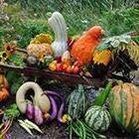Organic Industry Article - Reprinted

Too many fingers in the sacred cow pie!
(ORIGINAL UNEDITED VERSION OF AN ARTICLE PUBLISHED IN EDIBLE SHASTA BUTTE
MAGAZINE – by George Stevens)

Spring: time to focus on the opportunities and challenges we
face during this perfect storm of ecological and economic crises. The organic
and slow food movement took root simply because people need safe, healthy and
delicious food. The benefits are obvious for consumers and growers- it is a
win-win situation at the grassroots level.
Fast forward to the present where we labor under the ‘organic
industry’ paradigm of constant growth, an extension of the globalized food
system, not the secure local food economies we originally intended. Prices for
organic food are 500-1000 percent higher than they were 30 years ago: our
children and elders who desperately need organic food cannot afford it.
Our national organic program receives about $7million of
the $140billion USDA budget, about $1 per $20,000 spent. Organic research is
woefully underfunded even as the growth of organic and ‘natural’ foods sales
continues at 15-20%. The lions share goes to subsidize the overproduction
of corn and other commodity crops, and wasteful biofuels. Meanwhile a billion
humans suffer from hunger, and environmental devastation reaches a tipping
point. We are experiencing a moral/ ethical dilemma of titanic proportions.
In the months leading up to the adoption of the USDA ’organic
rule’, it dawned upon advocacy organizations that as many as half of their
growers were not going along with the concept of maximum-minimum certification.
That is to say the bar was set low enough to allow large scale conventional
farmers to get in the game, but nobody would be allowed to certify to a higher
standard.
Demeter- which certifies Biodynamic farmers- decried the NOP
rule, claiming infringement upon our constitutional right to free speech. NOFA
New York published its Farmers Pledge* incorporating environmental and social
justice issues into their programs in order to retain and support their
growers. But in California, we already had an organic rule that allowed organic
growers to register locally with our county agricultural commissioners. CCOF-
our leading organic certifier- lost up to half of its grassroots membership and
had to shift its focus to large scale commercial growers who require
certification in order to compete in what quickly became a global organic
market.
The consequences of this ‘certification’ system have been
distressing. Certification costs have increased as much as 1000% or more
because of the technicalities involved, and farmers can no longer serve on the
boards of certification organizations. Growers experience frustration and
distrust, as was expressed in the article ‘We Speak Organic Here’. And the
livelihoods of organic farmers dedicated to providing affordable quality food
to our local communities without using the USDA organic ‘seal’ have been
compromised.
For in depth discussion of this issue please read Sharing the
Harvest (by Elizabeth Henderson- NOFA, NY) Chapter 11: To Certify or Not to
Certify.
Is it fair for local organic farmers to be burdened with costly
certification and bureaucracy which insures that the organic market will always
be a high-end niche market while junk food gets a free ride? What would happen
with local food security if the requirement for organic certification was
lifted from $5,000 to $20,000 (gross receipts) or more? (for more on this
subject see addendum below) Should the same agency that intends to permanently
contaminate our food supply with genetically modified corn, soybeans, sugar
beets, canola and alfalfa be trusted to micromanage local organic agriculture?
In the last issue of Edible Shasta-Butte it was stated that
‘organic farms are generally supposed to use organic seeds’. Organic certifiers
and seed sellers insist that the NOP requires growers to do so. On its
face that seems to make perfect sense, but in practice that is not happening,
according to the State of Organic Seed (SOS) report available from the Organic
Seed Alliance (OSA). If you don’t have the time or patience to wade through
hundreds of pages of minutiae just go straight to the survey results: Farmers
report the use of organic seeds average about 10%.
When I spoke with longtime seedsaver -and former Los Molinos
organic farmer- Zea Sonnabend, who organizes the annual Eco-Farm conference and
advises CCOF and the American Seed Trade Association on organic seeds, she
summarized the issue as follows: “A lot of times the large-scale growers have
tried to use organic seeds but had crop failures”. Organic alternatives to
pesticides and fertilizers have been readily adopted but seeds are living
entities: you can’t just replace them overnight, and we have already lost over
90% of the regionally adapted seed diversity we had 100 years ago.
The good news is that the regenerative capacity of
open-pollinated and Heirloom seeds is there to be tapped by growers and
seedsavers at the local level. A closer look at the ‘SOS’ statistics reveals an
encouraging trend of organic farmers saving seed for their own use. This should
be a clarion call for gardeners and farmers alike to reclaim the commons of our
seed heritage and rededicate our efforts to identify, preserve, and recreate
the diversity of seed and food once enjoyed by our ancestors. Stayed tuned!
PS- If you are new to the whole cycle of growing for seed and
sustainability or are lacking in resources look for a work exchange with a
seedsaving gardener, farm or community supported agriculture project. Study up
on the subject: I recommend SEED TO SEED by Suzanne Ashworth. Also, FOUR SEASON
HARVEST by Eliot Coleman. and SHARING THE HARVEST by Elizabeth Henderson.
ADDENDUM– The
National Organic Program $5000 gross sales threshold for certification is an
absolute farce. In a recent broadcast interview on the locally produced
(KHSU.org) show ‘Food for Thought’, one of our local certification agents-
responsible for north coast organic dairy inspections- stated that as long as
growers spend the 2 hours a day keeping
their records up to date, her inspections would be expedited. If you
multiply that 2 hours a day, five days a week, 50 weeks a year, times $10 per
hour, that is costing the growers $5000 of time expended. So that first
$5000 of gross income is a total loss for small farmers, even if their
certification costs are government subsidized. This dramatically raises the
cost of organic food to consumers, giving mainstream conventional agriculture a
grossly unfair advantage in the marketplace.
Comments
No posts found


















































































